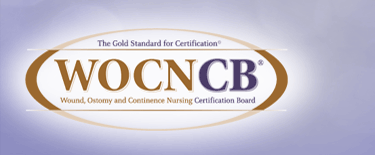History
Established January 1978
Examinations Began November 1979
| Historical background on the evolution of Enterostomal Therapists (ETs): | |
| 1958 | Rupert Turnbull, Jr., MD trains Norma Gill to rehabilitate ostomy patients. Dr. Turnbull coins the term "Enterostomal Therapist." |
| 1961 | Norma Gill and Dr. Turnbull begin training ETs at the Cleveland Clinic. |
| 1968 | American Association of Enterostomal Therapists (AAET) forms. |
| 1969 | Association name changed to North American Association for Enterostomal Therapy (NAAET). |
| 1971 | NAAET name changes to International Association for Enterostomal Therapy (IAET). |
| 1992 | IAET changes name to WOCN® Society (Wound, Ostomy, Continence Nurses Society) |
| January 1978 | IAET voted to establish a certification committee/board to plan and implement the certification of new graduates of accredited ET Nursing Education Programs (ETNEPs). The Psychological Corporation was chosen to develop, implement and evaluate the examination. |
| October 1978 | The certification committee/board voted to become a separate body from the Accreditation Committee and call themselves the ET Nursing Certification Board (ETNCB). The credential would be Certified in Enterostomal Therapy Nursing (CETN). Certification effective for 5 years. Students enrolled after 2/28/79 will be required to take the certification examination to be Board Certified. Others would be “granted” one certification period. All graduates prior to 2/29/78 must re-certify by 12/31/84. |
| November 1979 | First examination administered. |
| June 1984 | Terminated contract with Psychological Corporation. Qualifications changed to "must be officially graduated from ETNEP to be eligible." Non-nurse, LPN, LVN and RN were eligible. |
| November 1984 | Professional Testing Corporation begins contract as full service testing agency for the administration of the examinations. |
| 1985 | ETNEPs require a baccalaureate degree to enter programs. |
| 1992 | IAET changes name to WOCN Society (Wound, Ostomy, Continence Nurses Society) and opens membership to all nurses practicing in the field of wound, ostomy and/or continence care. |
| March 1993 | ETNCB changes name to WOCNCB. Offers 3 specialty examinations in addition to generalist (250 questions each.) Offers new credentials CWCN, COCN and CCCN. |
| November 1994 | Board decided to adopt policy initiated by ONS (Oncology Nurses Society) to require baccalaureate degree for initial certificants beginning in the year 2000. (Those already certified and maintaining continuous certification will be grandfathered.) Letter sent to non-nurse (LVN, LPN, ET) requesting that they relinquish the credential effective January 1995. |
| December 1995 | First NOCA meeting attended by WOCNCB representative. Many discoveries made related to standards, accepted credentialing practices (including NCCA Accreditation.) Board votes to pursue alternative methods to recertify. |
| March 1996 | Hired consultant to look at the Professional Growth Program (PGP) for recertification. Interviewed other testing corporations (RFP sent out). |
| May 1997 | Terminated contract with Professional Testing Company (PTC). Signed contract with Applied Measurement Professionals (AMP) to develop, implement and evaluate the credentialing program. |
| August 1997 | Job Analysis (Role Delineation) conducted. Job Analysis Committee convened to define tasks essential to practice. WOCNCB begins item bank analysis. Board voted to add the following eligibility pathways: 1. Graduate of a non-accredited graduate program in nursing with documentation of course work related to specialty. 2. 2000 Hour experiential pathway. |
| December 1997 | Examination Committee appointed (13 members). Pilot program for recertification via Professional Growth Program (PGP) began. |
| January 1998 | Began awarding CWOCN® (and CWCN®, COCN®, CCCN®) credentials to recertifying nurses. WOCNCB marketing booth designed and debuted at Multi-specialty Nursing Conference, Orlando, Florida. |
| March 1998 | Examination Committee convenes for the first time. Public Member added to the Board membership. "Ask the Board" website feature introduced. |
| June 1998 | First administration of the new WOCNCB examinations with 80 items on each examination (wound, ostomy, continence). Candidates select the examination(s) desired. New lapel pins stating "Certified by the Wound, Ostomy and Continence Nursing Certification Board" offered. |
| July 1998 | Marketing Committee formed. WOCNCB marketing booth premiers at the WOCN Annual Conference in Salt Lake City, Utah. Item writing session conducted by Larry Fabrey, Vice President, AMP, was held at the WOCN Annual Conference, Salt Lake City, Utah. |
| November 1998 | Board committed to computer-based testing beginning in 2002. Conflict of Interest Statement adopted by Board. Board votes to change criteria for Experiential Pathway to the following beginning in the year 2000: 1,500 clinical experience hours in the last 5 years for each specialty in which certification is sought. |
| April 1999 | Board votes to pursue Foot & Nail Certification. Board votes to change criteria for Experiential Pathway to the following beginning in the year 2000: 50 contact hours and 1,500 clinical experience hours in the last 5 years for each specialty in which certification is sought. Professional Growth Program Committee and Credentialing Review and Appeals Committee formed. |
| June 1999 | "Marketing Your Credential" pre-conference session held at the WOCN Annual Conference in Minneapolis, MN. Board votes to increase the number of Board members to 8 with staggered 4 year terms. |
| October 1999 | Foot & Nail Certification Advisory Committee formed. Board committed to a Foot & Nail Certification Job Analysis. |
| November 1999 | First open election of Board members held. |
| August 2000 | Professional Growth Program (PGP) Handbook developed. |
| 2000 | Sent surveys for Foot & Nail Certification job analysis. |
| 2001 | Received NCCA (National Commission for Certifying Agencies) accreditation. |
| June 2001 | Job Analysis sent out to certificants. |
| September 2001 | New test matrix based upon Job Analysis. |
| October 2001 | Computer-based testing. |
| January 2002 | Changed management firm to Executive Director, Inc. |
| August 2002 | Task Force formed to research feasibility of Advanced Practice (AP) credential for WOC nurses. |
| December 2002 | CETN credential officially retired. Self Assessment Examination (practice exam) available online. Professional Growth Program (PGP) Handbook revised. |
| September 2003 | Foot & Nail Advisory Panel met. Test blueprint and eligibility requirements for new foot and nail credential/exams finalized. |
| October 2003 | Professional Growth Program (PGP) Handbook revised. |
| December 2003 | Position Statement issued on Advanced Practice. |
| January 2004 | Examination Handbook revised. Foot and Nail Practice Analysis completed. |
| February 2004 | Foot & Nail Examination Committee formed. Test development in progress, planned for launch in 2005. Board approved eligibility requirements for candidates to apply for Foot & Nail credential exams. |
| October 2004 | Board agreed to move forward with WOC Advanced Practice credential. |
| January 2005 | Began administering Foot & Nail Examination for new credential, Certified Foot Care Nurse (CFCN®). |
| April 2005 | Advanced Practice role delineation survey sent. |
| June 2005 | Advanced Practice CWOCN certification via portfolio made available for Graduate level NP and CNS. (CWOCN-AP®) |
| November 11, 2005 | Board approved duo-specialty credential for wound/ostomy nurse, CWON® |
| March 2006 | Change to eligibility for Experiential Pathway, so that of the 1,500 hours clinical experience 375 must be completed within one year prior to certification application. CFCN candidates are now required to have eight hours of clinical experience if applying via the Experiential Pathway. |
| January 2006 | Began Hardship Assistance Program for qualified candidates applying. |
| May 2007 | Board agreed to implement an Ad Hoc Committee on Evidence-Based Practice. |
| September 2007 | Board approved to require any certificant with lapsed credentials greater than two years are required to prove eligibility via the Experiential Pathway, effective January 2008. Board approved to require candidates to successfully complete exam(s) within five years of graduation from a Wound, Ostomy, Continence Education Program, or they must then prove eligibility via the Experiential Pathway, effective January 2008. |
| February 2008 | Board approved when the WOCNCB makes a change in policy to eligibility criteria to (re)certify, the Board must provide written notification to its certificants and provide 1 year before the change goes into place. |
| March 2008 | Board approved members of the Board and all Committees actively involved in WOCNCB business will receive a two-year extension of all currently held WOCNCB credentials beyond their term of service and are exempt from recertification during their term of service. This does not include certifications earned in the future or after election or appointment to the Board or Committees - in other words, extensions are not grandfathered. |
| April 2008 | Board approved to move forward in the process for development and evaluation of Advanced Practice wound, ostomy, and/or continence specialty certification by examination. Board approved to move forward with Job Analysis for the LPN level. Board agreed NOT to offer non-BSN RN level. |
| May 2008 | Board approved to blend the Graduate Pathway requirements into the Experiential Pathway, stating that "candidates must either have 50 Continuing Education (CE) credits related to the specialty or college coursework credits equal to 50 CE credits." Effective August 2009. |
| January 2009 | Eligibility change. Experiential Pathway wording to state, “Within each specialty for which certification is sought, 50 contact hours (CEUs) or an equivalent in college course work post-Baccalaureate must be completed over the previous five years. All CEUs or college course work must directly apply to the specialty area for which applied. Effective Feb. 2010. |
| February 2009 | Board approved the CFCN Handbook for Recertification by Professional Growth Program (PGP portfolio). |
| April 2009 | Board approved the Credential Review Committee Charter to stipulate any extension beyond a six-month timeframe be reviewed by the full Board. |
| July 2009 | Board agreed to make the Committee on Evidence-Based Practice a standing committee. Board approved an Item Review Committee as a standing committee. |
| December 2009 | Board approved to require any certificant with lapsed credentials are required to prove eligibility via the Experiential Pathway, effective December 22, 2010. |
| July 2010 | Contracted with new testing firm, Castle Worldwide. |
| December 22, 2010 | Require that any certificant with lapsed credentials must prove eligibility via the Experiential Pathway |
| December 2010 | Board approved to launch AP exam in spring 2012. |
| March 2011 | Board approved to change the eligibility criteria for foot care exam candidates to say "completion of a foot care education program with 5 CE/CME credits (contact hours), and 8 clinical hours specific to foot care under the supervision of an expert, within the previous 5 years from the date of application, which must be earned while functioning as an RN." |
| June 2011 | Board approved more comprehensive appeals policy to allow candidates to appeal eligibility decisions, when an individual has been denied certification or recertification, based on a failure to satisfy application or eligibility requirements, pay fees required by WOCNCB, had a change in certification status, or failed the exam. |
| July 2012 | Board agreed to accept candidates with a Bachelor's degree who completed the Canadian Association of Enterostomal Therapists ETNEP program, and meet the published WOCNCB eligibility criteria (must exam within 5 years of WOC/ETN specialty program completion, RN licensure, and hold Bachelor's Degree). |
| November 2012 | Board agreed to accept all international candidates with a Bachelor's degree who completed a WCETNEP program, and meet the published WOCNCB eligibility criteria (must exam within 5 years of WOC/ETN specialty program completion, RN licensure, and hold Bachelor's Degree). |
| December 2012 | Role Delineation Study completed for W,O,C specialties. |
| January 2013 | Board approved only Exam Committee members may receive extension of credentials due to exposure to writing exam questions. |
| January 2014 | Board agreed to change eligibility for Certified Foot Care Nurse exams to require a Bachelor’s Degree effective January 1, 2015. |
| February 2014 | Exam lengthened to 120 questions for wound, ostomy, and continence specialties. Exam content outline updated. |
| May 2014 | Board agreed to change eligibility for Certified Foot Care Nurse exams to 25 CE credits and 40 precepted clinical experience hours effective May 1, 2015. |
| October 2014 | WOCNCB flash cards published for Wound Care specialty. |
| November 2014 | Board agreed to proceed with developing certification exam for the Wound Treatment Associate. |
| July 2015 | WOCNCB flash cards published for Ostomy Care specialty. |
| November 2015 | Board began administering certification exam for the Wound Treatment Associate – Certified (WTA-C). |
| April 2016 | Board approved CFCN eligibility clarification, that 8 of 24 CE may come from basic skin/wound care and 12 of 40 clinical hours may be in basic skin/wound care; plus re-certification by PGP portfolio language removed on “5 CE may be lower extremity” since some CE may be used in basic skin/wound care. |
| March 2017 | WOCNCB flash cards published for Continence Care specialty. |
| November 2018 | WTA-C Experiential Pathway launched. |
| April 2019 | WOCNCB flash cards published for Foot Care specialty. |
| May 2019 | WOCNCB launched mobile flash card apps for exam prep. |
| October 2019 | WOCNCB launched Certification Inspiration Podcast series. |
| September 2023 | WOCNCB receives Accreditation of Certified Foot Care Nurse (CFCN) from the Accreditation Board for Specialty Nursing Certification. |




